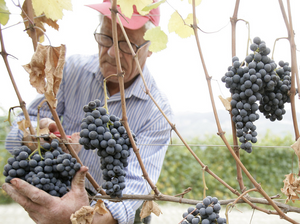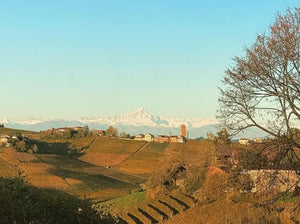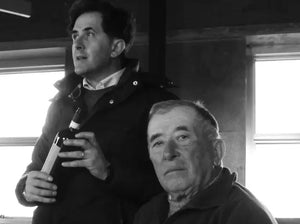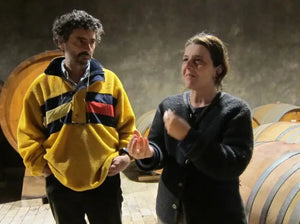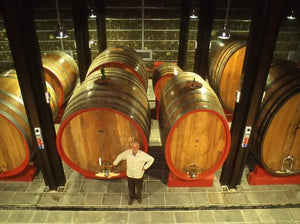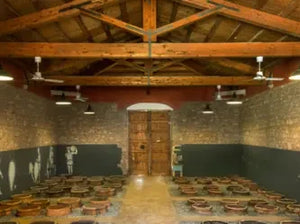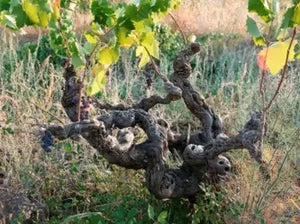Blog » Italy
-
Dolomite Dynamics: Foradori Teroldego & Singular Whites
The magical wines from the Foradori estate in Trentino's Dolomite Mountains have been well-documented here before, and I find an added layer of refinement and precision with each release. If you're curious about Italy's extreme alpine setting, Foradori is where I recommend you turn first.
Teroldego is an esoteric variety that opens with dark plum and licorice, followed by softer floral and herbaceous qualities, and finishes with a finely pronounced minerality. From the first sip to the last, Elisabetta's wines are constantly changing and fascinating to no end. The entry-level teroldego ages in neutral barrels and cement tanks while the old-vine, riserva-level "Granato ages in old foudres.
Elisabetta's father unexpectedly passed away while she was still in enology school, and after graduating, in 1984, she was thrust into harvest and production thereafter. Though her winemaking garnered awards in the 90s, the wines came into their own when she adopted biodynamic principles, eliminated lab yeasts, lowered sulfur additions, and included riper stems in the ferments. Visits with Giusto Occhipinti of COS introduced her to the use of clay amphora for aging. -
Alto Piemonte's One & Only: Ferrando Carema
Ferrando was the first European wine that Neal Rosenthal began importing to the U.S. in 1980. The following is still relatively small, but those who line their cellars with Giacomo Conterno and Bartolo Mascarello know the secret of Alto Piemonte. While pricing is always below the top examples of Nebbiolo from Barolo and Barbaresco, Ferrando's Carema deserves equal attention.
In the region of Canavese, these terraced vineyards sit at the foot of Monte Bianco. Here, Nebbiolo portrays an alpine inflection different from Barolo and Barbaresco but with the same track record of aging. Unlike their more famous southern neighbors, vines are trained high up on pergola to harness maximum sunlight. The Carema appellation is just 16 hectares of plantings, with Ferrando holding less than three.
Rosenthal's words have always stuck with me. He once declared that if given only one wine to drink, it would be Ferrando's Carema. Bottles going back to the late 70s are renowned for their freshness, unparalleled clarity, and underlying power. Looking at images of this alpine appellation reminds me of how this wine can come from nowhere else on earth. It is Nebbiolo at its most singular and awe-inspiring. -
Barolo's Royal Family: Giuseppe RinaldiRinaldi is a revered traditionalist following family techniques used since the early and mid-1900s. With long macerations on the skins aging in large botti, the results are powerfully deep Baroli met with precision and aromatics that make them incomparable. They offer wild spices, gamey notes, and of course, Nebbiolo's tell-tale tar and roses.The Giuseppe Rinaldi wines first appeared in 1921, though, it was during Beppe's lifetime that the world's attention turned toward Piedmont—Beppe's spirit is more immortalized than the legendary wines he produced. Sadly, he passed away in 2018, but he had several years to see his daughters, Marta and Carlotta, continue to raise the bar.
I visited the Rinaldi cantina just before harvest in 2012. It was nothing short of a privilege to meet the Rinaldi family and taste the wines, including the monumental 2010s still in botti. Finding back-vintage wines is not a common occurrence today, and I was thrilled to work with Rinaldi's US importer, Vinifera Imports, to acquire several older wines directly from the Rinaldi estate. -
Etna's Grand Cru Carricante: Benanti
Many have sought to express this distinct terroir from the eastern slope of the volcano, but one family is most synonymous with the greatest heights it has achieved. Etna doesn't have a classification system to rank estates or vineyards like Bordeaux and Burgundy, but if there was one Grand Cru white from these volcanic slopes perched over the Mediterranean, it would surely be Benanti's Pietra Marina.
Sourced from 80-year-old vines, Pietra Marina showcases Carricante at its most structured and age-worthy. While salinity is a hallmark of this grape variety, the defining element here is a tightly wrapped core of citrus, orange peel, and almond. There's a frame and touch of austerity to Pietra Marina that shows a discipline worlds apart from the more oxidative and plush style of wine commonly found in Milo. In the end, it's the vein of minerality and grip that appropriately put this benchmark bottling on the table with top Chablis and Burgundy.
Benanti's story began in the 1800s, but it was in 1988 that the estate began to garner fame. Giuseppe re-examined and questioned every aspect of Benanti's viticulture and winemaking, challenging conventional wisdom on clones and their compatibility in each parcel. Aging in stainless steel is a crucial element in keeping this southerly white wine so fresh and crisp. But make no mistake—it's these same qualities that give Pietra Marina its backbone to age in your cellar for many years to come. -
The Main Event: Vietti Cru BaroliVietti's Luca Currado worked tirelessly to continually improve the quality of his wines, and Barolo's reputation as a whole. These Nebbiolos from the most coveted Crus seem to receive praise year after year, but the 2019 vintage is especially impressive.Aside from being a banner year in Piedmont, 2013 cemented a shift in Currado's philosophy—now, the Barolo lineup is nearly exclusively aged in large format botti as opposed to small French barrique. (The Ravera was the first bottling to undergo this change in 2010, and the powerful Villero was the last in the range to do so in 2013).Many consider Vietti to have one foot in the traditional camp and one foot in the modern camp. In addition to aging in botti, the Baroli see long skin macerations (a requisite for the traditional category). If one aspect leans modern, it's their vineyard work, which is about keeping yields low and doing everything in their power by natural means to push ripeness higher. With the enviable lineup of vineyards, Vietti's lineup is always among the most collected in Piedmont.
-
Piedmont Perfection: Giacomo Conterno Barolo
In 2019, Roberto Conterno released only one Barolo, the Cerretta from Serralunga d'Alba. Arione and Vigna Francia will be put into the Riserva Monfortino for later release. Though also located in Serralunga, Cerretta shares a soil composition reminiscent of what's found across the valley in La Morra, where more elegant and less statuesque Barolos are commonly seen. The 2019 has bright red and black fruits with incredible focus, delineation, and a crystalline sense of purity that I love.
The King of Wines and the Wine of Kings. If one producer was tied to this moniker, it's undoubtedly Barolo's Roberto Conterno. From Giacomo to Giovanni to Roberto, this estate has been the standard bearer for the grandest wines in Italy—Nebbiolo from Serralunga d'Alba.
Visiting with Roberto in November 2012 offered a glimpse into the genius behind his quiet and reserved exterior. Conterno's immaculate cellar and eye for detail, specifically with cleanliness, are unlike anything I've seen in person. The methods here are traditional through and through. Still, one could point to vineyard practices as relatively modern, with a reliance on coaxing maximum ripeness from vines—I find this to be a massive element in why the dark and tannic Nebbiolo of Serralunga's terroir exudes so much charm when poured.
Purchased in 1974 by Giovanni Conterno, the flagship Francia is about the melding of power and finesse. Arione debuted in 2015, and now, with four releases under the stewardship of Roberto, we get to see even darker and more intense Serralunga terroir, where iron-tinged minerality meets lavender, orange peel, and menthol. -
Starbright Secret: Piero Busso Barbaresco
The 2016 vintage in Piedmont doesn't need an introduction, but the name Piero Busso might. Among the perfect vintage's success stories, Piero's Barbaresco from the Gallina cru has it all. The famous vineyard from Nieve is likely better known for Bruno Giacosa and Luca Roagna. Still, Piero's expression floored us for its immediacy yet age-worthy structure.
This Gallina is all about perfume and bright aromatics, like the best 2016s show in spades. On the palate, a thrilling concentration of red berries with mint have loads of gripping intensity, and the finish is classic Barbaresco with that more dusty minerality finely woven through, compared to Barolo's broader tannic personality.
A sense of grace and understated elegance jumps out of the glass. When we all tried our first sip in San Diego, we looked at each other and knew the obvious greatness captured in this 2016 rendition. While Piero Busso and his Gallina Barbaresco are always a match made in heaven, this exceptional vintage is drinking beautifully right now with so much upside in the cellar.
-
Trebbiano on the Skins: Paolo Bea Arboreus Bianco
Paolo Bea is most famous for its wildly interesting take on Montefalco's Sagrantino red grape variety, but today, I’d like to pivot to their orange wines. Paolo's son, Giampiero, was one of the first naturalists in Italy to adopt the practices of Josko Gravner and Stanko Radikon (the Friulian winemakers who repopularized the ancient-old tradition of fermenting white grapes on their skins). Today, Bea’s Arboreus is considered a benchmark in the world of orange wine, and it has a fascinating backstory.
These Trebbiano Spoletino vines were planted below oak trees on the Paolo Bea estate over 120 years ago and have completely wrapped themselves around the trees (Hence the name Arboreus). Once harvested and de-stemmed, the grapes ferment on the skins for several weeks and spend a minimum of two years on the lees in stainless steel tanks. Gravner and Radikon produce the most concentrated, structured examples of orange wine you’ll come across and are undoubtedly the pinnacles in this category. I more often gravitate toward Paolo Bea's style, though. Arboreus has that same deep amber hue, golden stone fruit showing apricot and yellow plum, powerful tannins—but with an added streak of freshness that balances its other components. Note: This is a great food wine with the tannins to take one heavier foods than typical whites (Lamb kabobs and saffron rice were on my mind when we tasted this).
If you prefer your orange wines, well, less orange-y, consider Lapideus. The grape variety, soil type, and winemaking are the same as Arboreus (same skin-contact and élevage regimen). Except, these 80-year-old Trebbiano Spoletino vines, trained in the traditional cordon method, grow in a cooler microclimate, resulting in a leaner, more acid-driven orange wine. Paolo Bea provides a counterpoint to the argument that this style of wine can’t be terroir-driven! There are also Monastero Suore Cistercensi’s orange wines, Coenobium and Ruscum, as value-driven options. Based in Lazio, these wines are farmed and produced by the Sisters of the Cistercian order, with some guidance from Giampiero.
Lastly, I highly recommend reading Giampiero's interview with Sprudge Wine, which includes a photo of those stunning Arboreus vines. If you are a skin-contact fanatic, like me, Paolo Bea is a must-try, as these were the among the defining wines for what's now a booming category. -
Giovanna's Chianti: Le Boncie
When I have the opportunity to prove that Chianti Classico can show grace and pristine fruit quality akin to Red Burgundy, I use Giovanna Morganti's Le Boncie as my first example. I implore you to trust this will be your moment of clarity for Sangiovese.
Importer Neal Rosenthal's Montevertine is a benchmark for the region, but his other discovery, Le Trame, better illustrates Sangiovese's sometimes elusive, fruit-forward profile and silken tannins. Also consider Chiesamonti, which comes from a one-hectare parcel in Castelnuovo Berardenga. The stonier soils here result in a wine with brighter red fruits and a long saline finish (Differing from Giovanna's other wines that exhibit more fleshy characteristics). These two Chiantis are all class.
Giovanna farms her five hectares using organic and biodynamic principles. I could go down the rabbit hole on farming, fermentation, and aging specifics, but I'd like to cut this one short and say: This is a profound wine that's a joy to drink. I've lost count of the number of times I've used this bottling to convince friends that Sangiovese can be fun, approachable, and deadly serious. Below is a photo from my 2017 visit and the gorgeous color of the Stockinger barrel sample that had me in love. -
The Epitome of Montalcino: Gianfranco Soldera
Soldera on the Casse Basse estate is hallowed ground in Montalcino. Founded in 1972 by Gianfranco Soldera, it's still one of Italy's most mysterious and celebrated addresses. Soldera is known for their rigorous standards in the vineyard, and selection in the cuverie is ruthless. The wines are featherweight, age-worthy beyond compare, and a model upon which all others in Montalcino follow suit.
The late Gianfranco was on vacation during my visit in 2017, but touring with his son-in-law, Paolo, who manages production, was a detailed exploration. The estate's 10 hectares of vines are adjacent to a mesmerizing garden with hundreds of flowers. The vineyard's hillside is composed of clay and galestro, a schist rock that can be broken apart in your hands, allowing vines to travel deep below the surface for nutrients. The vines grow freely, modeled after Lalou-Bize Leroy in Burgundy. But the real turn of events with the farming is the shockingly low yields, with some vines reduced to as few as three clusters prior to harvest.
The role of selection became a great theme. Soldera believes each vintage has an optimal berry size. They have a de-stemming machine that disposes of grapes outside the preferred dimensions. These select grapes ferment in massive old wood fermenters and get transferred to botti for elévage. Sulfur additions are essentially zero. After the required two years of aging, the wine goes directly from botti to bottling line, minimizing the movement as much as humanly possible.
Sampling the gorgeous 2013 vintage from botti was a haunting experience. The wine was shockingly transparent and light, beginning with its fabled weightless frame, then a saturating and deep grip. The tannins are never forceful, but that's not to underestimate the aging intended for this wine. Sangiovese takes on so many forms in Montalcino and Chianti, but here at Soldera, it seems to exist on its own plane. There's no doubt in my mind after visiting that this site is truly magical, but it's the difficult choices that are made at every stage that allow a wine of this magnitude to come to life. -
Dreamers of Vittoria: COS
There's no better introduction to Sicily's Vittoria than the dream project started by Giambattista Cilia, Giusto Occhipinti, and Cirino Strano (COS) in 1980. These groundbreakers put the once obscure Frappato and Nero d'Avola on the world map!
Driving from Mt. Etna to Vittoria reminded me just how varied the landscape and terroir of Sicily were. Temperatures rose, and the climate turned arid. It was hard to believe the place I was heading was beloved for the freshness and clarity of its wines.
They key? There's a constant breeze going through the Hyblaean mountains, and the vines here are on red clay and sand over a deep bedrock of limestone. The wind helps moderate the inland temperatures, the red sand cooling immediately after sunset, and the limestone is responsible for low pH levels in the wine, giving high acidity and nervy minerality.
I visited Giusto Occhipinti just as they were bottling a new vintage. The wines we tasted were fermented in cement and aged in large Slavonian oak casks, similar to one's used for traditional Barolo and Brunello. This technique ensures the wines accentuate crisp, refreshing notes that make the wines a joy to drink. -
Old-School Mt. Etna: Massimiliano Calabretta
“I make my wine like Bartolo Mascarello!” That's what Massimiliano Calabretta told his U.S. importer when they first visited his estate in Sicily. The family's formula is simple: To work with old-vine and own-rooted parcels preserved as long as possible through organic farming. Their historic practices have stood the test of time as the world around them rapidly changed. The wines at Calebretta are entrenched in tradition, just as Bartolo Mascarello would have approved.
Nerello Cappuccio is often considered a blending grape (mainly because of its viticulture difficulty and susceptibility to disease than any varietal shortcoming). Calabretta saw his old, ungrafted vines offered a very different expression of the variety, with an aromatic lift that stood apart from his counterparts: Dark red fruits, smoke, lavender, violets, and a saline-infused finish that has made reaching for this wine habitual.
Nerello Mascalese is the primary red variety on Mt. Etna. The vines for Calabretta's old-vine cuvée, Vigne Vecchie, start at 60 years old and go well over 100 years, many of which are un-grafted. Aging takes place in 50-70 hectoliter Slavonian casks for up to 42 months. This protocol draws parallels to traditional Barolo producers, but the similarities go beyond aging formats.
.svg?v=162776257677185172071724397232)








